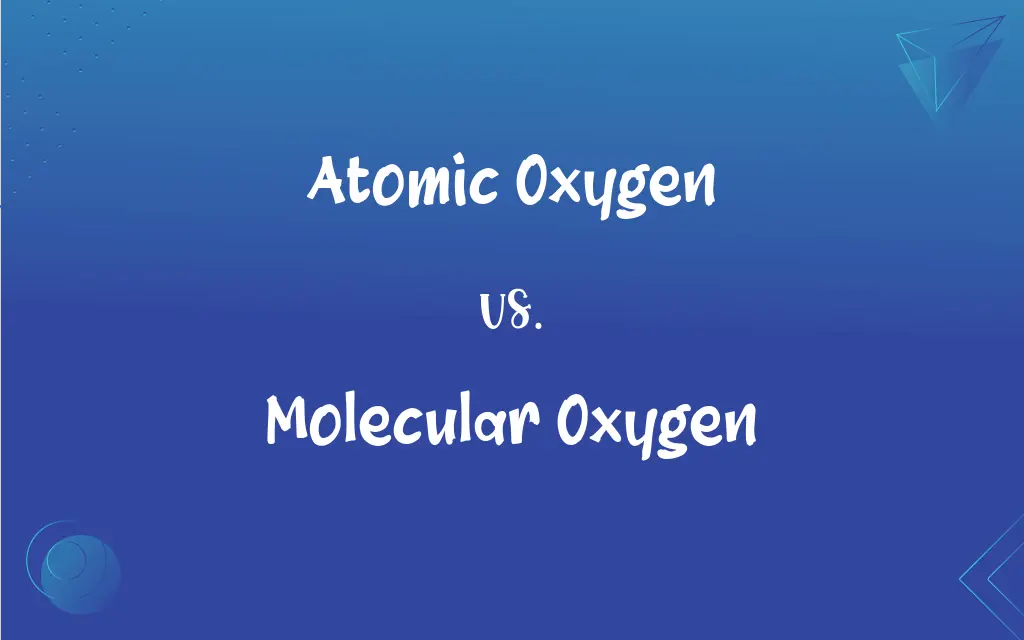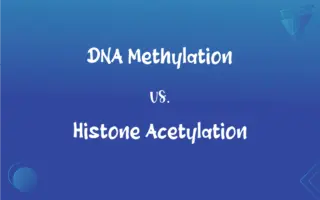Atomic Oxygen vs. Molecular Oxygen: What's the Difference?
By Harlon Moss & Janet White || Published on March 20, 2024
Atomic oxygen consists of single oxygen atoms, highly reactive and rare on Earth, while molecular oxygen, O2, is stable, essential for life, and makes up about 21% of the Earth's atmosphere.

Key Differences
Atomic oxygen, denoted as O, refers to individual oxygen atoms, known for their high reactivity and short-lived nature in Earth's lower atmosphere. They are more common in the upper atmosphere, particularly in the thermosphere, where solar radiation dissociates molecular oxygen. Molecular oxygen, or O2, consists of two oxygen atoms bonded together, forming a stable diatomic molecule. This form of oxygen is vital for most life forms on Earth, supporting processes like respiration and combustion.
The high reactivity of atomic oxygen makes it a potent agent in chemical reactions, particularly in the upper atmosphere, where it plays a significant role in the formation and degradation of important ozone (O3) molecules. In contrast, molecular oxygen is relatively stable and is a key component of the Earth's biosphere, making up approximately 21% of the Earth's atmosphere.
Atomic oxygen's presence is limited to specific conditions, such as high altitudes or in laboratory settings, due to its tendency to quickly react and form more stable compounds like molecular oxygen or ozone. Molecular oxygen, however, is abundant and forms a critical part of the air we breathe, contributing to the oxidative processes essential for life.
Despite their differences, both forms of oxygen play crucial roles in Earth's atmospheric chemistry. Atomic oxygen is involved in complex high-altitude chemical reactions, including those that affect the ozone layer, which protects life on Earth from harmful ultraviolet radiation. Molecular oxygen, aside from its biological importance, also plays a role in atmospheric and oceanic processes, influencing climate and the carbon cycle.
Comparison Chart
Form
Single oxygen atoms
Two oxygen atoms bonded together
ADVERTISEMENT
Stability
Highly reactive and short-lived
Relatively stable and long-lived
Presence on Earth
Rare in the lower atmosphere, more common in the upper atmosphere
Abundant, making up about 21% of the Earth's atmosphere
Role in Life Processes
Limited direct role due to reactivity
Essential for respiration and combustion
Environmental Impact
Plays a role in high-altitude chemical reactions, including ozone formation and degradation
Vital for the biosphere, influences climate and the carbon cycle
Atomic Oxygen and Molecular Oxygen Definitions
Atomic Oxygen
Atomic oxygen is highly reactive.
It quickly reacts to form molecular oxygen in the Earth's lower atmosphere.
ADVERTISEMENT
Molecular Oxygen
It's a major atmospheric component.
O2 makes up about 21% of the Earth's atmosphere.
Atomic Oxygen
Rare under normal conditions.
Atomic oxygen exists momentarily before forming more stable compounds.
Molecular Oxygen
Involved in corrosion.
Oxygen in the air reacts with metals, leading to rust.
Atomic Oxygen
Vital for ozone layer dynamics.
Atomic oxygen combines with O2 to form ozone, protecting against UV radiation.
Molecular Oxygen
Stable under standard conditions.
O2 remains a diatomic molecule without reacting spontaneously.
Atomic Oxygen
Produced in laboratories.
Atomic oxygen is generated for scientific studies using plasma generators.
Molecular Oxygen
Crucial for aerobic respiration.
Humans and animals inhale O2 for energy production.
Atomic Oxygen
It's prevalent in the upper atmosphere.
Atomic oxygen affects the lifespan of satellites by causing oxidation.
Molecular Oxygen
Molecular oxygen supports combustion.
O2 is essential for burning fuels in engines and stoves.
FAQs
What role does molecular oxygen play in climate change?
While O2 itself is not a greenhouse gas, it is involved in various processes, such as the combustion of fossil fuels and the carbon cycle, which are relevant to climate change.
Can humans breathe pure oxygen?
Humans can breathe pure oxygen for short periods under controlled conditions, but prolonged exposure can be harmful.
Can atomic oxygen be found on other planets?
Yes, atomic oxygen has been detected in the atmospheres of other planets and moons, where it contributes to their chemical dynamics and can be a product of photodissociation processes similar to those on Earth.
How is atomic oxygen created?
Atomic oxygen is created by the dissociation of molecular oxygen, O2, primarily due to solar radiation in the upper atmosphere.
What happens to molecular oxygen at high temperatures?
At high temperatures, molecular oxygen can dissociate into atomic oxygen and participate in various high-energy chemical reactions.
Why is molecular oxygen important for life?
Molecular oxygen is crucial for aerobic respiration, allowing organisms to convert nutrients into energy.
How does atomic oxygen affect spacecraft?
Atomic oxygen in the upper atmosphere can cause significant oxidation and damage to spacecraft materials.
How does the reactivity of atomic oxygen impact atmospheric chemistry?
The high reactivity of atomic oxygen drives many chemical reactions in the upper atmosphere, including the formation of ozone and other reactive oxygen species, influencing atmospheric composition and dynamics.
Where is atomic oxygen most commonly found?
Atomic oxygen is most commonly found in the Earth's upper atmosphere, especially in the thermosphere.
Can atomic oxygen be used in medical treatments?
Yes, atomic oxygen has been explored for medical applications, including sterilization and in certain therapies.
How does the presence of atomic oxygen influence ozone layer dynamics?
Atomic oxygen is crucial in the ozone layer's formation and maintenance; it reacts with molecular oxygen (O2) under UV radiation to form ozone (O3), which in turn protects the Earth from harmful UV rays.
What is the significance of molecular oxygen in the water cycle?
Molecular oxygen, dissolved in water bodies, is vital for the survival of aquatic life forms that rely on dissolved oxygen for respiration, thus playing an essential role in aquatic ecosystems.
How do oxygen levels affect aerobic and anaerobic organisms?
Aerobic organisms require molecular oxygen for energy production, while anaerobic organisms thrive in environments with little to no oxygen, often being harmed by high oxygen levels.
How does the balance between atomic and molecular oxygen affect space missions?
The balance between atomic and molecular oxygen is critical in designing spacecraft materials and systems, as atomic oxygen can cause significant erosion to exposed surfaces in low Earth orbit.
What role does molecular oxygen play in the carbon cycle?
Molecular oxygen is involved in the carbon cycle through processes like photosynthesis, where it's produced, and respiration and combustion, where it's consumed, thus playing a pivotal role in carbon exchange between the Earth's spheres.
Is atomic oxygen a pollutant?
While not a pollutant in the traditional sense, atomic oxygen can contribute to material degradation in the upper atmosphere.
What are the industrial applications of molecular oxygen?
Molecular oxygen is used in various industries, including steel production, chemical manufacturing, and waste treatment, due to its role in combustion and oxidation processes.
How are atomic and molecular oxygen measured in the atmosphere?
Specialized instruments and satellites measure atomic and molecular oxygen in the atmosphere, using techniques like spectrometry and remote sensing to monitor their concentrations and distribution.
How do plants contribute to the level of molecular oxygen?
Plants produce molecular oxygen as a byproduct of photosynthesis, contributing to its abundance in the atmosphere.
What safety precautions are necessary when handling pure molecular oxygen?
Pure molecular oxygen can greatly enhance combustion, so handling it requires proper ventilation, non-flammable materials, and strict adherence to safety protocols to prevent fires and explosions.
About Author
Written by
Harlon MossHarlon is a seasoned quality moderator and accomplished content writer for Difference Wiki. An alumnus of the prestigious University of California, he earned his degree in Computer Science. Leveraging his academic background, Harlon brings a meticulous and informed perspective to his work, ensuring content accuracy and excellence.
Co-written by
Janet WhiteJanet White has been an esteemed writer and blogger for Difference Wiki. Holding a Master's degree in Science and Medical Journalism from the prestigious Boston University, she has consistently demonstrated her expertise and passion for her field. When she's not immersed in her work, Janet relishes her time exercising, delving into a good book, and cherishing moments with friends and family.































































